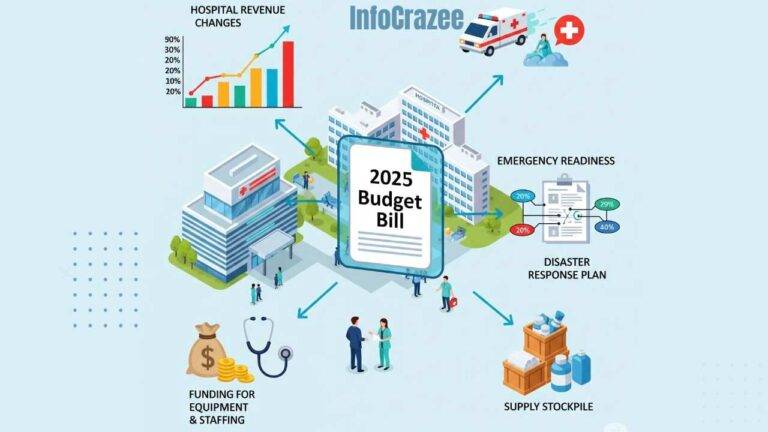Ambient Intelligence in Healthcare: Key Examples and Benefits
Ambient Intelligence (AmI) is revolutionizing healthcare in 2025 by creating smart, responsive environments that seamlessly integrate sensors, AI, and IoT to enhance patient care, streamline operations, and improve outcomes. Defined as context-aware systems that proactively adapt to user needs, AmI is transforming hospitals, clinics, and homes into intelligent ecosystems. With healthcare facing challenges like rising costs (global spending projected to hit $10.9 trillion by 2030) and staffing shortages (1.22 million job losses projected due to 2025 U.S. budget cuts), AmI offers a scalable, efficient solution. This blog explores key examples of AmI in healthcare, its benefits, and the challenges to widespread adoption, emphasizing its potential to reshape care delivery.
What is Ambient Intelligence in Healthcare?
Ambient Intelligence combines sensors, AI, and connectivity to create environments that anticipate and respond to human needs without explicit input. In healthcare, AmI leverages data from wearables, smart devices, and environmental sensors to monitor patients, optimize workflows, and enhance safety. Unlike traditional systems requiring manual interaction, AmI operates unobtrusively, using real-time data to deliver personalized, proactive care. For example, a smart hospital room might adjust lighting based on a patient’s circadian rhythm or alert staff to a fall risk, all without human intervention.
Key Examples of Ambient Intelligence in Healthcare
1. Smart Hospital Rooms
- Functionality: Equipped with IoT sensors, AI-driven cameras, and voice-activated systems, smart rooms monitor patient vitals, detect anomalies, and automate tasks. For instance, Philips’ IntelliSpace platform uses AmI to adjust room conditions (e.g., temperature, lighting) based on patient needs and alert staff to critical events like irregular heart rates.
- Real-World Impact: A 2024 trial at Cleveland Clinic reduced nurse response times by 30% by using AmI to prioritize alerts, improving patient safety and staff efficiency.
- Use Case: Fall prevention systems in rooms use AI-powered motion sensors to detect high-risk movements, reducing fall incidents by 25%, per a 2025 Journal of Healthcare Engineering study.
2. Remote Patient Monitoring (RPM)
- Functionality: Wearables and home-based IoT devices, integrated with AI, continuously track patient health metrics (e.g., heart rate, glucose levels) and share data with providers. Biofourmis’ RPM platform, enhanced by AmI, predicts health events like heart failure exacerbations days in advance.
- Real-World Impact: A 2025 pilot with ActiGraph’s RPM system in rural U.S. hospitals reduced readmissions by 20% by enabling early interventions, addressing access gaps exacerbated by budget cuts.
- Use Case: Elderly patients with chronic conditions benefit from AmI-driven alerts that prompt timely medication reminders or telehealth consultations.
3. Intelligent Clinical Decision Support
- Functionality: AmI systems integrate EHR data, real-time vitals, and AI analytics to provide context-aware clinical recommendations. For example, GE Healthcare’s Command Center uses AmI to predict patient deterioration, optimizing bed allocation and staff deployment.
- Real-World Impact: A 2024 deployment at Johns Hopkins reduced ICU transfer delays by 15%, improving outcomes for critical patients.
- Use Case: AmI flags potential sepsis cases by analyzing subtle changes in vitals, enabling early treatment and reducing mortality rates by 18%, per a 2025 HealthTech Magazine report.
4. Smart Operating Theaters
- Functionality: AmI-equipped operating rooms use sensors and AI to monitor equipment, track surgical progress, and enhance precision. Stryker’s Mako system integrates AmI to guide robotic-assisted surgeries, adapting to real-time anatomical data.
- Real-World Impact: A 2025 study in Surgical Innovation found that AmI-driven robotic systems reduced surgical errors by 22% in orthopedic procedures.
- Use Case: Real-time sterilization monitoring ensures compliance with infection control protocols, critical amid rising healthcare-associated infections.
5. Voice-Activated Assistants for Patients and Staff
- Functionality: AI-powered assistants, like Amazon’s Alexa for Healthcare, use AmI to respond to voice commands, retrieve patient data, or automate administrative tasks. These systems learn user patterns to provide context-aware support.
- Real-World Impact: A 2024 rollout in Cedars-Sinai improved patient satisfaction by 30% by enabling hands-free access to care instructions and appointment scheduling.
- Use Case: Nurses use voice assistants to update EHRs, reducing documentation time by 25%, per a 2025 Healthcare IT News report.
Benefits of Ambient Intelligence in Healthcare
1. Enhanced Patient Outcomes
- AmI’s real-time monitoring and predictive analytics enable early interventions, reducing complications. For example, RPM systems cut heart failure readmissions by 38% in a 2024 NEJM Catalyst study.
- Personalized care, driven by context-aware data, improves adherence to treatment plans, particularly for chronic disease management.
2. Operational Efficiency
- Automation of routine tasks, like environmental adjustments or documentation, frees staff for patient care. A 2025 HIMSS report noted a 20% reduction in administrative workload in AmI-equipped hospitals.
- Predictive bed management optimizes resource allocation, addressing capacity constraints in rural facilities facing budget cuts.
3. Improved Safety and Compliance
- AmI reduces human error through automated alerts and monitoring, critical for infection control and patient safety. A 2025 Journal of Patient Safety study reported a 15% drop in medication errors with AmI systems.
- Compliance with HIPAA and GDPR is streamlined through secure, context-aware data handling, reducing breach risks amid a 27% rise in ransomware attacks (2023–2024).
4. Cost Savings
- By preventing readmissions and optimizing workflows, AmI delivers significant ROI. A 2024 Health Affairs analysis estimated $1.2 billion in annual savings for U.S. hospitals adopting AmI for RPM.
- Rural hospitals, facing $70 billion in Medicaid cuts over 10 years, benefit from low-cost AmI solutions like wearable-based monitoring.
5. Enhanced Patient and Staff Experience
- Patients enjoy seamless, personalized interactions, boosting satisfaction. A 2025 Patient Experience Journal survey found 65% of patients preferred AmI-enabled care settings.
- Staff burnout is reduced by automating repetitive tasks, critical as 44% of rural hospitals report staffing shortages in 2025.
Challenges to Adoption
Despite its promise, AmI faces barriers in healthcare:
- Cost and Infrastructure: High initial costs for IoT and AI systems strain budgets, particularly for rural hospitals already impacted by 2025 budget cuts.
- Interoperability: Integrating AmI with legacy EHR systems remains complex, with 60% of hospitals reporting compatibility issues in a 2024 KLAS Research survey.
- Data Privacy: Continuous monitoring raises concerns about PHI security, requiring robust encryption and compliance measures.
- Staff Training: Limited IT expertise in rural settings necessitates user awareness training, aligning with Microsoft’s 2024 Cybersecurity for Rural Hospitals Program.
Strategies for Successful Implementation
To maximize AmI’s benefits, healthcare organizations should:
- Leverage Partnerships: Collaborate with vendors like Philips or NTT DATA, which launched a Microsoft Cloud unit in 2025, to access scalable, secure solutions.
- Start Small: Pilot AmI in high-impact areas like RPM or smart rooms to demonstrate ROI before full-scale deployment.
- Prioritize Cybersecurity: Integrate AmI with next-generation firewalls and user training to mitigate ransomware risks, as emphasized in a 2025 HealthTech Magazine report.
- Invest in Training: Use short, role-specific modules to upskill staff, drawing on Microsoft’s success in training 1,000 rural hospital staff in 2024.
The Future of Ambient Intelligence
By 2030, AmI is expected to dominate healthcare, with the global IoT healthcare market reaching $405 billion, per a 2025 IndexBox report. Advancements in edge AI, 5G connectivity, and generative AI (e.g., GPT-5) will enable real-time, hyper-personalized care. For example, Osaka University’s 2024 CNN-based organoid research suggests AmI could predict treatment outcomes using real-time imaging, enhancing precision medicine. Rural healthcare, facing closure risks, will benefit from low-cost, cloud-based AmI solutions, ensuring equitable access to intelligent care.
Conclusion
Ambient Intelligence is transforming healthcare by creating proactive, data-driven environments that enhance patient outcomes, streamline operations, and reduce costs. From smart hospital rooms to remote monitoring, AmI’s applications are already delivering measurable benefits, particularly for resource-constrained rural facilities. However, addressing cost, interoperability, and cybersecurity challenges is critical to widespread adoption. By partnering with technology leaders, prioritizing training, and leveraging scalable solutions, healthcare organizations can harness AmI to navigate financial pressures and deliver high-quality, patient-centered care in 2025 and beyond.


![Write page title Page titles should be around 580 pixels in length. Or meta description Meta descriptions should be around 920 pixels in length. On[ Healthcare Mergers and Acquisitions: Key Highlights from 2025 ] that is clear, simple, and engaging, using a friendly and conversational tone. Avoid generic or overly formal words like "delve," "comprehensive," or "leverage." Instead, use natural language that feels human and relatable. Structure the content with headings, subheadings, and bullet points to make it easy to scan and read.please give me Focus keyphrase.](https://infocrazee.com/wp-content/uploads/2025/08/wfucgw-dpcsjx-7-768x432.jpg)


